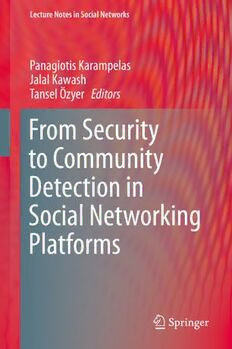Table Of ContentLecture Notes in Social Networks
Panagiotis Karampelas
Jalal Kawash
Tansel Özyer Editors
From Security
to Community
Detection in
Social Networking
Platforms
Lecture Notes in Social Networks
Serieseditors
RedaAlhajj,UniversityofCalgary,Calgary,AB,Canada
UweGlässer,SimonFraserUniversity,Burnaby,BC,Canada
HuanLiu,ArizonaStateUniversity,Tempe,AZ,USA
RafaelWittek,UniversityofGroningen,Groningen,TheNetherlands
DanielZeng,UniversityofArizona,Tucson,AZ,USA
AdvisoryBoard
CharuC.Aggarwal,YorktownHeights,NY,USA
PatriciaL.Brantingham,SimonFraserUniversity,Burnaby,BC,Canada
ThiloGross,UniversityofBristol,Bristol,UK
JiaweiHan,UniversityofIllinoisatUrbana-Champaign,Urbana,IL,USA
RaúlManásevich,UniversityofChile,Santiago,Chile
AnthonyJ.Masys,UniversityofLeicester,Ottawa,ON,Canada
CarloMorselli,SchoolofCriminology,Montreal,QC,Canada
Moreinformationaboutthisseriesathttp://www.springer.com/series/8768
Panagiotis Karampelas (cid:129) Jalal Kawash
Tansel Özyer
Editors
From Security to Community
Detection in Social
Networking Platforms
123
Editors
PanagiotisKarampelas JalalKawash
DepartmentofInformatics&Computers DepartmentofComputerScience
HellenicAirForceAcademy UniversityofCalgary
Dekelia,Greece Calgary,AB,Canada
TanselÖzyer
DepartmentofComputerEngineering
TOBBUniversityofEconomics
andTechnology
Ankara,Turkey
ISSN2190-5428 ISSN2190-5436 (electronic)
LectureNotesinSocialNetworks
ISBN978-3-030-11285-1 ISBN978-3-030-11286-8 (eBook)
https://doi.org/10.1007/978-3-030-11286-8
LibraryofCongressControlNumber:2019935126
©SpringerNatureSwitzerlandAG2019
Thisworkissubjecttocopyright.AllrightsarereservedbythePublisher,whetherthewholeorpartof
thematerialisconcerned,specificallytherightsoftranslation,reprinting,reuseofillustrations,recitation,
broadcasting,reproductiononmicrofilmsorinanyotherphysicalway,andtransmissionorinformation
storageandretrieval,electronicadaptation,computersoftware,orbysimilarordissimilarmethodology
nowknownorhereafterdeveloped.
Theuseofgeneraldescriptivenames,registerednames,trademarks,servicemarks,etc.inthispublication
doesnotimply,evenintheabsenceofaspecificstatement,thatsuchnamesareexemptfromtherelevant
protectivelawsandregulationsandthereforefreeforgeneraluse.
Thepublisher,theauthors,andtheeditorsaresafetoassumethattheadviceandinformationinthisbook
arebelievedtobetrueandaccurateatthedateofpublication.Neitherthepublishernortheauthorsor
theeditorsgiveawarranty,expressorimplied,withrespecttothematerialcontainedhereinorforany
errorsoromissionsthatmayhavebeenmade.Thepublisherremainsneutralwithregardtojurisdictional
claimsinpublishedmapsandinstitutionalaffiliations.
ThisSpringerimprintispublishedbytheregisteredcompanySpringerNatureSwitzerlandAG.
Theregisteredcompanyaddressis:Gewerbestrasse11,6330Cham,Switzerland
Preface
Introduction
This volume is a compilation of the best papers presented at the IEEE/ACM
International Conference on Advances in Social Networks Analysis and Mining
(ASONAM-2017), held in Sydney, Australia, August 2017. The authors of the
selected papers were kindly asked to provide extended versions of the papers that
werethensubjectedtoanadditionalrefereeingprocess.Withinthebroadercontext
ofonlinesocialnetworks,thevolumefocusesonimportantandstate-of-the-artwork
intheareaofdetectionandpredictiontechniquesusinginformationfoundgenerally
ingraphsandparticularlyinsocialnetworks.
FromSecuritytoCommunityDetectioninSocialNetworking
Platforms
Social networks have not only been under the light due to the vast participation
of users but also because they are a very reliable source of information either for
collectingsecurity-relatedinformation,suchasmaliciousIPaddresses,ordetecting
onlinecommunitiesindiversecontextsusinginnovativetechniques,suchasgenetic
algorithms or surface tension analysis. Additionally, the absence of authentic data
due to privacy concerns is addressed. This absence complicates testing novel
methodologiesinvariousareassuchasfinancialanalysisorminingofunstructured
data. Two other chapters present solutions for creating synthetic though realistic
data for the aforementioned cases. The rest of the chapters presented in this book
propose innovative methods to explore graphs and social networks in an attempt
to provide timely, reliable, and useful results in a continuously increasing data-
intensiveenvironment.Thevarietyofapproachesadoptedintheresearchpresented
in the book demonstrates the diversity of the application contexts and can act as a
source for further research not only in the designated areas presented but in other
areasofapplication.
v
vi Preface
Thefirstchapterexamineshowsocialnetworkanalysiscanbeappliedinacom-
plex environment where numerous actors are involved in preserving biodiversity
in a protected area. By applying social networking metrics in two ego networks,
the authors study the role of the management actors for the preservation of the
area at stake and how these metrics can assist in improving the cooperation of
environmentalconservationinNatura2000areas.
Inthesecondchapter,theauthorsproposeanovelmethodologytodetectsocial
network communities without estimating the number of communities beforehand
using a modified genetic algorithm. The reported results have shown that the
proposedmethodologyperformsverywelleveninlargedatasets.
Inthethirdchapter,theauthorsrecognizingtheproliferationofthemultidimen-
sionalityofcurrentsocialnetworksproposeanovelMultidimensionalCommunities
Detection Algorithm that is capable of handling outliers and at the same time is
able to detect multidimensional communities. The proposed technique can also
automatically unfold the hidden communities in a multidimensional context, by
creatinganovelpropagationrulethatexploitsthemostfrequentlyusedinteraction
dimensionsamongneighborsasanadditionalconstraintformembershipselections.
Thefourthchapterproposestwomethodsfordetectinglocalcommunities.The
firstoneproposesfindingderivativesingraphspaceand,asaresult,takesadvantage
ofderivative-basedmethodsintographtheory.Thesecondisinspiredbytheactive
contour algorithm in computer vision and explores the concepts of curvature and
gradient of the community’s boundary. The proposed methods are enhanced by
applyingtheprinciplesofsurfacetensionfromchemistryindynamicnetworksby
addingnewnodes.Theexperimentspresentedprovidepromisingresultsregarding
theperformanceoftheproposedmethods.
In the fifth chapter, the authors propose a new graph embedding approach
for attributed graph clustering since nowadays rich and heterogeneous attribute
informationhasbecomewidelyavailableespeciallyinsocialnetworksuserprofiles.
Byapplyingtheproposedmethodology,theauthorsdemonstratethatitispossible
to transform the challenging attributed graph clustering problem into a multi-
dimensional data clustering problem. This transformation outperforms traditional
attributedgraphclusteringtechniquesintermsofeffectivenessandefficiency.
The sixth chapter elaborates on the problem of big graph analytics in dynamic
graphs. Traditional methods rely on tracking the added or the removed nodes in
a graph. The proposed technique takes advantage of additional information that is
available by creating the Edge Sample and by employing the discard algorithm,
whichgeneratesanunbiasedestimateofthetotalnumberoftrianglesthatmayneed
to be updated due to dynamic changes. The proposed method is evaluated against
traditionalmethodsprovidingpromisingresults.
Intheseventhchapter,theauthorsfocusontheproblemofsemi-structuredand
structureddatathatareusedindecision-making.Eventhoughthereareseveraldata
qualitymanagementapproaches,itisnotalwaysfeasibletocompareorassessthe
performanceofthespecificapproachessincetherearenopublicdatasetsavailableto
beusedforsuchpurpose.Thechapteraddressesthespecificchallengebyproposing
a system that is able to produce synthetic semi-structured and structured data
Preface vii
satisfying a set of integrity constraints to be used for the assessment of the data
qualitymanagementmethods.
In the eighth chapter, the authors propose a novel methodology for randomly
generating entire financial systems while diagnosing the absence of real financial
trade datasets for analyzing the impact of financial regulation concerning the
collateralization of derivative trades. Based on a novel open-source risk engine,
the authors enable data scientists to apply diverse techniques such as data mining,
anomalydetection,andvisualizationtorunsimulations.
Theninthchapteridentifiestheneedforminingunstructuredinformation,such
asinhackers’forums,andproposesanovelmethodologyandacorrespondingtool
based on matrix decomposition method to extract latent features of the behavioral
information of the users. These features are then used along with some keywords
from any language to classify malicious IP addresses found in the forums. Based
ontheexperimentalanalysis,theauthorsareabletodetectuptothreetimesmore
maliciousIPaddressthantheblacklistofVirusTotal.
The tenth and final chapter proposes a method for detecting topic changes
between different time periods. The proposed method is based on two techniques:
one is from an information-theoretic analysis of the terms distributions, and the
secondisbasedondocumentclusteringinperiodsunderreview.Thevalidityofthe
proposedmethodistestedagainstvariousTwitterdatasets.
Dekelia,Greece PanagiotisKarampelas
Calgary,AB,Canada JalalKawash
Ankara,Turkey TanselÖzyer
Contents
Real-World Application of Ego-Network Analysis to Evaluate
EnvironmentalManagementStructures ...................................... 1
Andreea Nita, Steluta Manolache, Cristiana M. Ciocanea,
andLaurentiuRozylowicz
AnEvolutionaryApproachforDetectingCommunitiesinSocial
Networks.......................................................................... 17
KorayOzturk,FarukPolat,andTanselÖzyer
OnDetectingMultidimensionalCommunities................................ 45
AmaniChouchane,OualidBoutemine,andMohamedBouguessa
DerivativesinGraphSpacewithApplicationsforFinding
andTrackingLocalCommunities.............................................. 79
M.AminRigi,IreneMoser,andM.MehdiFarhangi
GraphClusteringBasedonAttribute-AwareGraphEmbedding.......... 109
EsraAkbasandPeixiangZhao
OnCountingTrianglesThroughEdgeSamplinginLarge
DynamicGraphs ................................................................. 133
GuyueHanandHarishSethu
GenerationandCorruptionofSemi-StructuredandStructuredData .... 159
SamirAl-janabiandRyszardJanicki
ADataScienceApproachtoPredicttheImpactofCollateralization
onSystemicRisk ................................................................. 171
SharynO’Halloran,NikolaiNowaczyk,DonalGallagher,
andVivekSubramaniam
ix
x Contents
MiningActionableInformationfromSecurityForums:TheCase
ofMaliciousIPAddresses....................................................... 193
JoobinGharibshah,TaiChingLi,AndreCastro,KonstantinosPelechrinis,
EvangelosE.Papalexakis,andMichalisFaloutsos
TemporalMethodstoDetectContent-BasedAnomalies
inSocialMedia ................................................................... 213
JacekSkryzalin,RichardFieldJr.,AndrewFisher,andTravisBauer
Index............................................................................... 231

